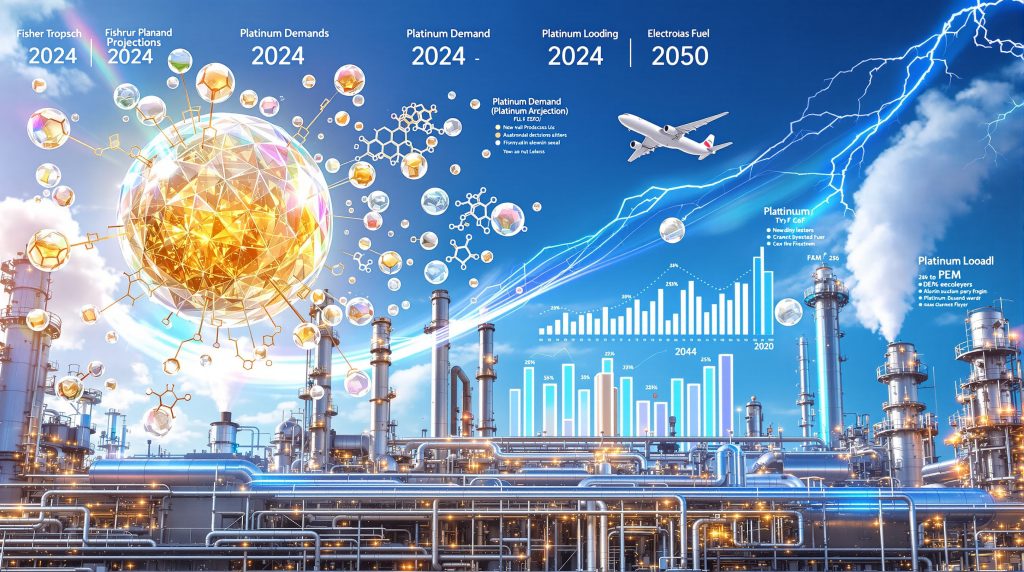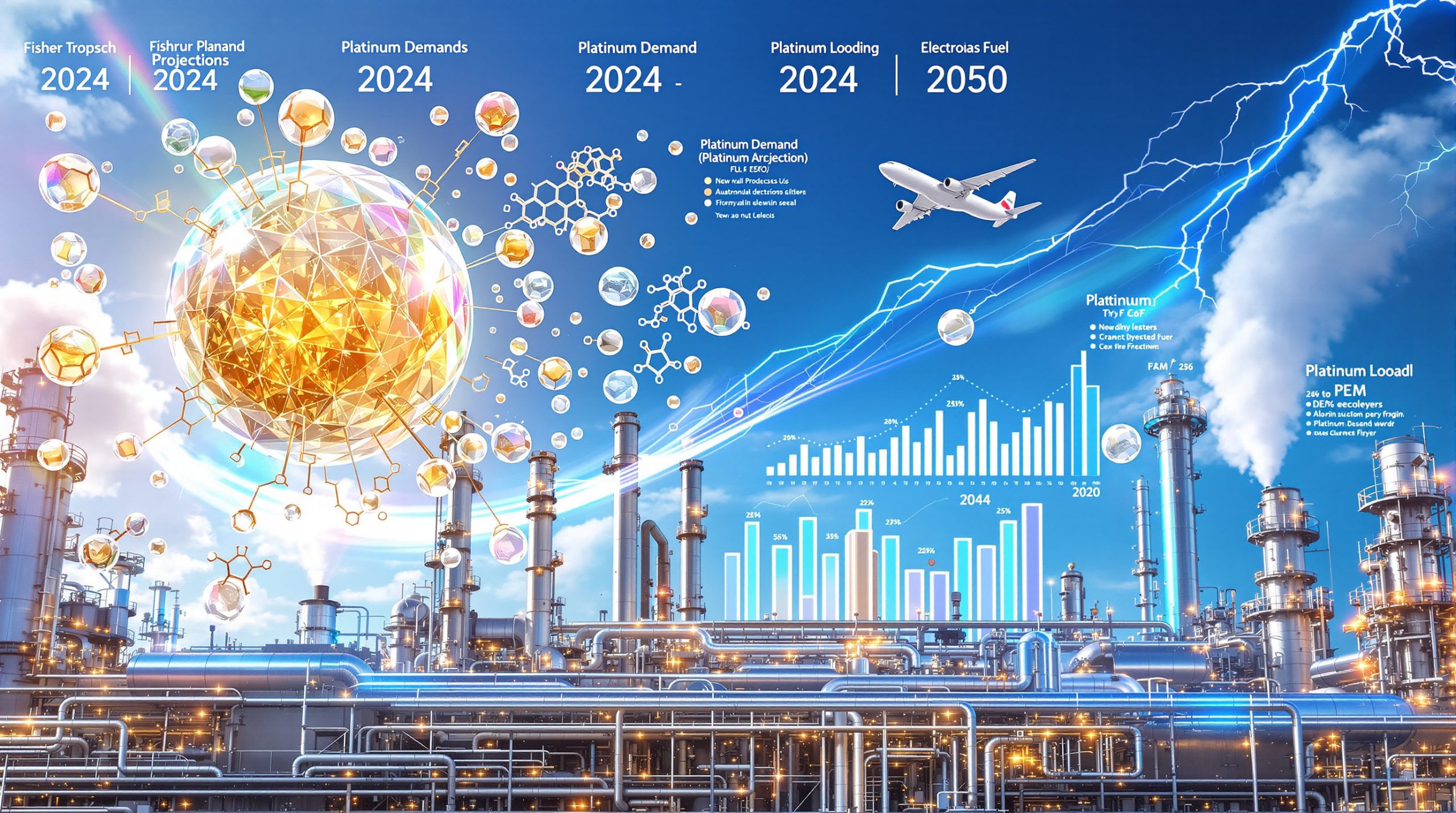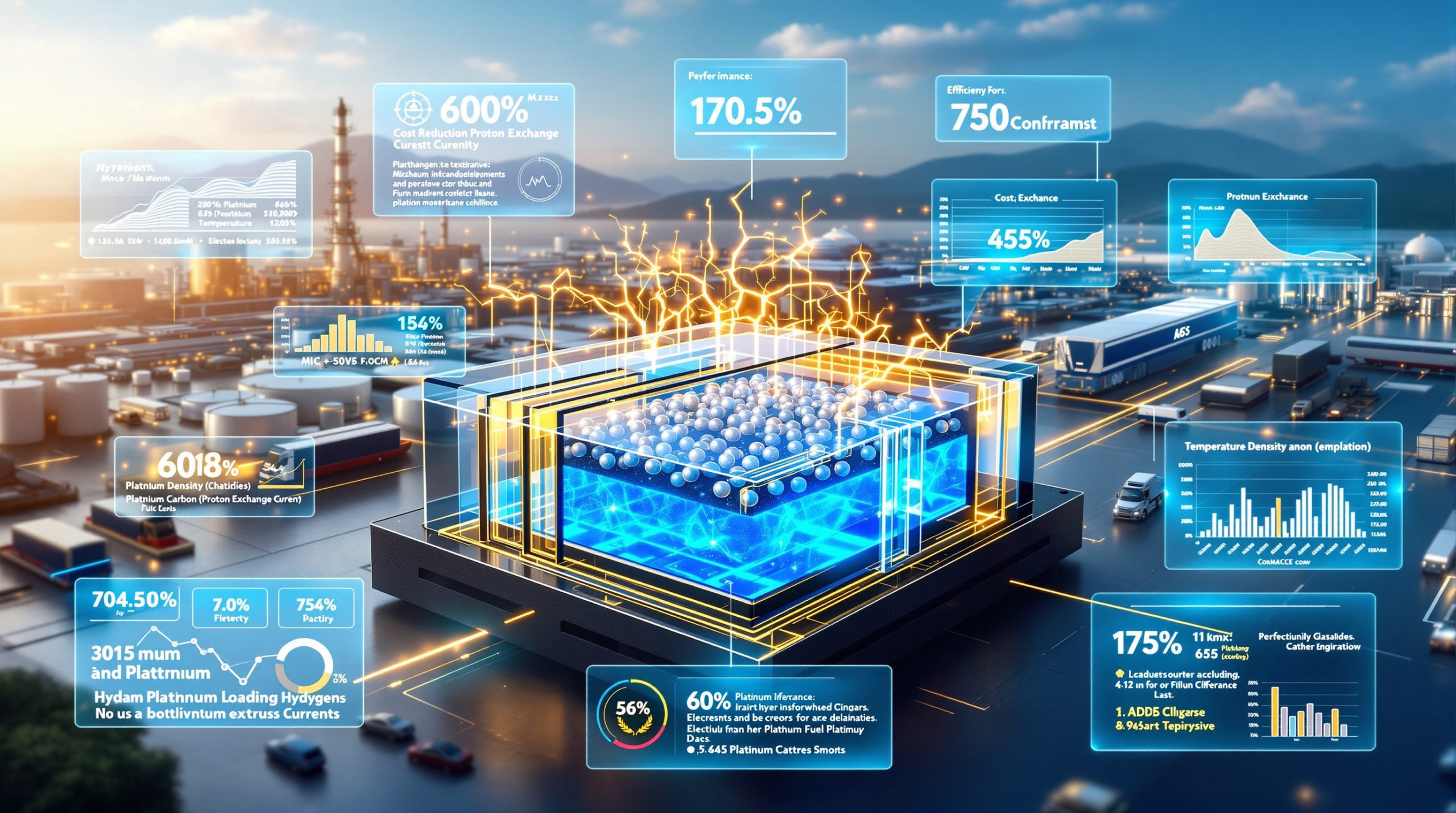Understanding Platinum's Catalytic Role in Next-Generation Jet Fuel Manufacturing
The transformation of aviation fuel production represents one of the most complex industrial chemistry challenges facing manufacturers today. Within the intricate molecular engineering processes required to create sustainable aviation fuel, platinum demand in sustainable aviation fuel emerges as an irreplaceable catalyst component across multiple production pathways. Unlike conventional petroleum refining operations, SAF manufacturing demands precise molecular restructuring that depends entirely on platinum's exceptional electronic configuration and surface chemistry properties.
The metal's unique ability to facilitate hydrocarbon transformation reactions positions it as fundamentally different from other catalytic materials. Where traditional refining processes rely on thermal cracking and basic catalytic conversion, sustainable aviation fuel production requires sophisticated molecular manipulation that can only be achieved through platinum's distinctive catalytic mechanisms.
Current industry assessments indicate that platinum demand in sustainable aviation fuel production will grow from negligible volumes in 2024 to approximately 260,000 ounces annually by 2050. This projection represents a fundamental shift in platinum consumption patterns, creating new industrial demand as traditional automotive catalyst applications potentially decline during electric vehicle adoption. Furthermore, this transformation aligns with the broader critical minerals energy transition shaping global energy security strategies.
What Are the Primary SAF Production Pathways Requiring Platinum Catalysts?
Power-to-Liquid Fischer-Tropsch Systems
Power-to-Liquid technology creates climate-neutral carbon feedstocks by combining renewable electricity-derived hydrogen with captured carbon dioxide. This synthesis pathway demonstrates platinum's multi-stage catalytic involvement across the entire production chain, from initial electrolysis through final fuel refinement.
The electrolytic hydrogen generation phase utilizes proton exchange membrane systems operating at 50-80°C with platinum-based cathode catalysts. Industrial-scale electrolyser units typically require platinum loadings of 0.3-0.5 mg per square centimeter of membrane electrode assembly, establishing significant base metal requirements for large-capacity facilities.
Fischer-Tropsch cobalt catalyst systems benefit from platinum promotion even at concentrations below 1% by weight. Research demonstrates that platinum addition improves cobalt catalyst reduction efficiency, enhances dispersion characteristics, and extends operational lifetime by 15-25% compared to unpromoted catalyst formulations. Moreover, these developments reflect the broader mining industry evolution toward more sophisticated processing technologies.
Technical specifications for PtL systems include:
• Operating temperature ranges: 200-300°C for optimal cobalt catalyst performance
• Pressure requirements: 20-50 bar for effective Fischer-Tropsch synthesis
• Hydrogen/carbon monoxide ratios: 2:1 stoichiometric with operational flexibility between 1.8-2.2:1
• Space velocity parameters: 5,000-15,000 h⁻¹ gas hourly space velocity
Biomass-to-Liquid Processing Pathways
Biomass gasification creates synthesis gas from agricultural residues, forestry waste, and municipal solid waste feedstocks. The resulting syngas composition typically contains 35-45% carbon monoxide, 25-30% hydrogen, 10-15% carbon dioxide, and 5-8% methane, requiring extensive conditioning before Fischer-Tropsch synthesis.
Iron-based catalysts dominate biomass Fischer-Tropsch processing and do not utilize platinum as a promotional element. However, platinum's role emerges in downstream processing stages where heavy Fischer-Tropsch waxes require hydrocracking to achieve jet fuel specifications.
The conversion of C₃₀+ hydrocarbons to C₈-C₁₆ jet fuel range molecules necessitates platinum-containing hydrocracking catalysts operating at 300-350°C under 50-100 bar hydrogen pressure. These systems achieve greater than 95% conversion of heavy waxes while maintaining selectivity toward aviation fuel range products. Consequently, this process integration supports the renewable energy transformations in mining sector through sustainable feedstock utilisation.
Syngas conditioning requirements include:
• Sulfur compound removal through platinum-catalyzed hydrotreating processes
• Trace metal contamination mitigation using platinum guard bed systems
• Carbon monoxide/hydrogen ratio optimization for downstream synthesis
• Nitrogen compound elimination to prevent catalyst poisoning
Why Is Isomerisation Critical for Aviation Fuel Specifications?
Aviation fuel freezing point requirements represent one of the most stringent specifications in petroleum chemistry. Commercial aviation demands fuel that maintains fluidity below -47°C, while high-altitude flight operations require performance at temperatures exceeding -60°C during cruise conditions at 35,000-43,000 feet altitude.
Straight-chain paraffin molecules exhibit high freezing points due to strong intermolecular Van der Waals forces that enable crystallization at elevated temperatures. Without molecular modification, Fischer-Tropsch derived hydrocarbons would solidify in fuel lines, creating catastrophic safety risks during flight operations.
Platinum-catalyzed isomerisation transforms straight-chain molecules into branched isomers through metal-acid bifunctional mechanisms. The process involves three sequential steps:
-
Platinum-catalyzed dehydrogenation converts n-alkanes to olefin intermediates
-
Acid-catalyzed carbocation formation enables intramolecular rearrangement reactions
-
Platinum-catalyzed rehydrogenation produces branched alkane products with superior cold-flow properties
This molecular restructuring reduces freezing points by 10-25°C depending on branching degree, enabling SAF to meet critical aviation specifications. Platinum loading rates of 0.3-0.8 weight percent on acidic supports achieve 70-85% conversion of straight-chain hydrocarbons while maintaining 95-98% selectivity toward mono- and di-branched isomers.
| Property | Requirement | Measurement Standard |
|---|---|---|
| Freezing Point | Below -47°C | ASTM D2386 |
| Flash Point | Minimum 38°C | ASTM D56 |
| Thermal Stability | Stable at 150°C+ | ASTM D3241 |
| Density Range | 0.775-0.840 g/mL | ASTM D1298 |
How Much Platinum Will SAF Production Consume by 2050?
The projected expansion of sustainable aviation fuel capacity creates unprecedented demand growth patterns for platinum consumption. Industry forecasts indicate SAF production capacity will increase eight-fold from 2 million tonnes in 2024 to 16 million tonnes by 2050, establishing entirely new industrial applications for platinum group metals. This growth trajectory, according to global platinum investment research, positions platinum demand in sustainable aviation fuel as a key driver of market transformation.
Platinum demand projections demonstrate exponential growth characteristics:
| Year | SAF Capacity | Platinum Demand | Annual Growth Rate |
|---|---|---|---|
| 2024 | 2.0 million tonnes | Negligible | Baseline |
| 2030 | 5.5 million tonnes | 45,000 ounces | 275% increase |
| 2040 | 11.2 million tonnes | 155,000 ounces | 344% increase |
| 2050 | 16.0 million tonnes | 260,000 ounces | 168% increase |
The 260,000 ounce annual demand by 2050 represents approximately 4.2% of current global platinum production, providing meaningful demand diversification without creating supply constraints. This incremental growth offers strategic balance as automotive catalyst demand potentially declines during electric vehicle market penetration.
The International Air Transport Association estimates that sustainable aviation fuel could contribute 65% of emissions reduction needed by aviation to achieve net-zero emissions by 2050. This assessment underscores the strategic importance of platinum-catalyzed SAF production pathways for achieving global climate objectives. Furthermore, these developments align with comprehensive mining sustainability transformation initiatives across extractive industries.
What Catalyst Loading Rates Drive Platinum Consumption?
Electrolyser System Requirements
Proton exchange membrane electrolysers utilize platinum loadings of 0.3-0.5 mg per square centimeter of membrane electrode assembly. Industrial-scale hydrogen production facilities operating at multi-megawatt capacity require substantial platinum inventories to achieve target production rates.
Current density parameters of 1-2 A/cm² for commercial electrolyser systems establish direct correlations between production capacity and platinum consumption. A 100-megawatt electrolyser facility typically requires 150-250 ounces of platinum for initial catalyst loading, with replacement cycles every 5-7 years depending on operating conditions.
Fischer-Tropsch Catalyst Specifications
Cobalt-based Fischer-Tropsch catalysts employ platinum concentrations of 0.1-0.3 weight percent as promotional elements. These loading rates provide optimal balance between catalytic performance enhancement and economic efficiency, achieving maximum conversion improvements at minimum platinum consumption.
Industrial Fischer-Tropsch reactor systems require:
• Catalyst volumes of 50-200 cubic meters for commercial-scale facilities
• Platinum consumption of 500-2,000 ounces per reactor during initial loading
• Catalyst replacement intervals of 3-5 years for cobalt-based systems
• Regeneration capabilities extending catalyst lifetime by 50-70%
Isomerisation Unit Platinum Requirements
Isomerisation catalysts utilize platinum concentrations of 0.3-0.8 weight percent on acidic supports to achieve target conversion rates and selectivity profiles. These systems process 100% of Fischer-Tropsch liquid products, making isomerisation catalyst requirements directly proportional to total SAF production capacity.
Processing parameters for isomerisation units include:
• Operating temperatures of 200-250°C for optimal selectivity
• Hydrogen pressures of 20-30 bar to maintain platinum dispersion
• Catalyst replacement cycles of 2-4 years depending on feedstock quality
• Platinum recovery rates of 85-95% through recycling processes
Which Feedstock Types Influence Platinum Catalyst Requirements?
Waste Oil Processing Challenges
Waste cooking oil and used vegetable oil feedstocks contain elevated sulfur concentrations, chloride compounds, and trace metals that significantly impact platinum catalyst performance. Sulfur content typically ranges from 10-50 ppm compared to less than 1 ppm in virgin feedstocks, necessitating increased platinum loading rates for effective hydrotreating operations.
Catalyst deactivation rates increase 20-30% when processing waste oils due to contaminant accumulation on platinum active sites. This performance degradation requires more frequent catalyst regeneration cycles and higher replacement platinum consumption compared to virgin feedstock processing.
Waste oil impact factors include:
• Phosphorus compounds causing irreversible platinum catalyst poisoning
• Sodium and potassium salts creating physical catalyst bed plugging
• Free fatty acid content affecting downstream processing efficiency
• Water content requiring additional dehydration processing stages
Municipal Solid Waste Gasification
Municipal solid waste gasification produces synthesis gas containing trace metal contaminants including mercury, cadmium, lead, and zinc compounds. These metals accumulate on platinum catalyst surfaces, gradually reducing catalytic activity and requiring specialized mitigation strategies.
Guard bed catalyst systems consume additional platinum for contaminant removal, increasing total platinum requirements by 15-20% compared to clean feedstock processing. Advanced purification stages utilize platinum-containing catalysts for sulfur compound removal and trace metal capture before synthesis gas enters Fischer-Tropsch reactors. Additionally, these processing challenges highlight the importance of critical minerals recycling initiatives in maintaining supply chain security.
Municipal waste processing complications:
• Chlorine compounds creating corrosive operating environments
• Nitrogen-containing compounds causing reversible catalyst deactivation
• Ash content requiring additional separation equipment
• Variable feedstock composition affecting process optimization
How Do Different SAF Production Scales Affect Platinum Demand?
Small-Scale Distributed Production
Facilities producing 10,000-50,000 tonnes annually demonstrate higher platinum intensity per unit of SAF produced due to less efficient catalyst utilization and more frequent replacement cycles. Small-scale operations typically lack advanced catalyst management systems and regeneration capabilities available at industrial-scale facilities.
Distributed production characteristics include:
• Platinum loading rates 40-60% higher than optimized large-scale systems
• Catalyst replacement frequencies 2-3 times more frequent than industrial facilities
• Limited access to platinum recovery and recycling infrastructure
• Reduced economies of scale for catalyst procurement and management
Large-Scale Centralized Facilities
Production facilities exceeding 200,000 tonnes annual capacity achieve optimized catalyst management through advanced regeneration systems and sophisticated process control. These operations extend catalyst lifetime by 50-70% compared to smaller facilities while maintaining superior conversion efficiency and product quality.
Large-scale operational advantages:
• On-site catalyst regeneration reducing platinum consumption by 30-40%
• Integrated platinum recovery systems achieving 95% metal recovery rates
• Advanced process optimization minimizing catalyst deactivation rates
• Economies of scale enabling platinum inventory management strategies
What Technical Challenges Affect Platinum Catalyst Performance in SAF Production?
Catalyst Poisoning Mechanisms
Sulfur compounds represent the most significant threat to platinum catalyst activity, reducing catalytic efficiency by 30-50% at concentrations above 1 ppm. Hydrogen sulfide and organic sulfur compounds chemically bond to platinum active sites, creating irreversible deactivation that requires catalyst replacement or intensive regeneration procedures.
Nitrogen-containing compounds cause reversible platinum catalyst deactivation through competitive adsorption mechanisms. While this poisoning can be reversed through appropriate regeneration procedures, it reduces instantaneous catalyst activity and affects process economics.
Trace metal accumulation from feedstock impurities:
• Iron compounds depositing on catalyst surfaces reducing accessibility
• Alkali metals (sodium, potassium) disrupting acid-metal balance
• Heavy metals (mercury, cadmium) forming alloys with platinum particles
• Silicon compounds creating physical barriers on catalyst surfaces
Operating Condition Optimization
Platinum catalysts demonstrate optimal activity within specific temperature ranges of 200-350°C depending on reaction type and catalyst formulation. Operations outside these parameters result in reduced conversion efficiency, altered selectivity patterns, and accelerated catalyst deactivation rates.
Pressure optimization requirements:
• Fischer-Tropsch synthesis: 20-50 bar for cobalt-platinum catalysts
• Isomerisation processing: 20-30 bar hydrogen partial pressure
• Hydrotreating operations: 50-100 bar for optimal sulfur removal
• Electrolyser systems: 20-30 bar for PEM stack optimization
Hydrogen partial pressure maintenance becomes critical for preserving platinum dispersion characteristics and preventing sintering-induced activity loss. Insufficient hydrogen pressure leads to platinum particle agglomeration, permanently reducing catalytic surface area and requiring catalyst replacement.
How Does SAF Production Compare to Traditional Petroleum Refining for Platinum Use?
Catalyst Loading Comparisons
Traditional petroleum refining utilizes platinum primarily in catalytic reforming units with loading rates of 0.3-0.6 weight percent and operational lifespans of 2-4 years. SAF isomerisation requirements demand similar or higher platinum concentrations of 0.3-0.8 weight percent but achieve extended catalyst lifespans of 3-5 years due to cleaner feedstock characteristics.
Power-to-Liquid electrolyser applications represent entirely new platinum consumption patterns with loading requirements of 0.4 mg/cm² and operational lifespans extending 5-7 years. This application creates sustained platinum demand independent of traditional petroleum refining cycles.
| Application | Platinum Loading | Catalyst Lifetime | Market Trend |
|---|---|---|---|
| Petroleum Reforming | 0.3-0.6 wt% | 2-4 years | Declining |
| SAF Isomerisation | 0.3-0.8 wt% | 3-5 years | Rapidly Growing |
| PtL Electrolysis | 0.4 mg/cm² | 5-7 years | Emerging Technology |
Industrial Transition Implications
The shift from petroleum-based to sustainable aviation fuel production creates fundamental changes in platinum consumption patterns and geographic distribution. Traditional refining centers may experience reduced platinum demand while new SAF production facilities establish alternative consumption nodes.
Economic transition factors include:
• Petroleum catalyst demand declining 2-4% annually through 2040
• SAF catalyst demand increasing 15-25% annually through 2035
• Geographic redistribution of platinum consumption toward renewable energy centers
• Technology transition creating temporary supply-demand imbalances
What Role Does Catalyst Recycling Play in Platinum Supply Management?
Recovery Technology Capabilities
Modern SAF facilities incorporate platinum recovery systems achieving 85-95% metal recovery rates through sophisticated processing techniques. Spent catalyst treatment involves thermal processing to remove organic deposits, chemical leaching to extract platinum compounds, purification to catalyst-grade specifications, and remanufacturing into fresh catalyst formulations.
Advanced recycling processes include:
• High-temperature oxidation removing carbonaceous deposits
• Selective dissolution extracting platinum from support materials
• Purification achieving 99.95% platinum purity standards
• Remanufacturing into specifications matching virgin catalyst performance
Economic Recovery Analysis
Platinum recycling economics demonstrate favorable returns due to high metal value and efficient recovery rates. Processing costs typically range from 15-25% of virgin platinum value, creating substantial economic incentives for comprehensive recycling program implementation.
Recovery system benefits:
• Reduced fresh platinum requirements by 40-60% over facility lifetime
• Shortened payback periods for recycling infrastructure investment
• Enhanced supply chain security through reduced external platinum dependence
• Environmental benefits through reduced mining pressure and waste generation
How Will Emerging SAF Technologies Affect Future Platinum Demand?
Advanced Electrolyser Development
Solid oxide electrolysers operating at 700-900°C may reduce platinum requirements by 60-70% through alternative electrode materials and improved electrochemical efficiency. These systems utilize ceramic electrolytes enabling non-platinum cathode catalysts while maintaining comparable hydrogen production rates.
Proton ceramic electrolysers represent breakthrough technology potentially eliminating platinum cathode requirements entirely through novel ionic conduction mechanisms. Commercial deployment timelines indicate market availability between 2030-2035, creating potential disruption to platinum demand in sustainable aviation fuel projections.
Novel Catalyst Formulations
Single-atom platinum catalysts demonstrate 3-5x efficiency improvements compared to traditional nanoparticle formulations, potentially reducing total platinum consumption while maintaining superior catalytic performance. These atomically dispersed catalysts maximize platinum utilization through enhanced active site density.
Research initiatives focus on platinum-free alternatives for specific SAF production applications, particularly in isomerisation and hydrotreating processes. Breakthrough developments in zeolite chemistry and metal-free catalyst systems could alter long-term platinum demand scenarios after 2040. However, the hydrogen economy's reliance on platinum group metals suggests sustained demand across multiple energy sectors.
What Investment Implications Emerge from SAF Platinum Demand Growth?
Market Diversification Opportunities
The projected 260,000 ounce annual platinum demand by 2050 creates meaningful diversification away from automotive catalyst applications during electric vehicle market penetration. This transition provides platinum producers with alternative demand sources as traditional markets potentially contract.
Strategic investment considerations include:
• SAF catalyst demand offering 15-20 year visibility compared to automotive volatility
• Geographic concentration creating regional platinum pricing opportunities
• Technology learning curves reducing catalyst loading requirements over time
• Recycling infrastructure development presenting secondary market opportunities
Supply Chain Security Factors
Long catalyst lifecycles in SAF applications create steady replacement demand cycles rather than volatile procurement patterns typical in other industrial applications. This demand stability enables improved supply chain planning and inventory management strategies for platinum producers and consumers.
The development of integrated SAF production and catalyst recycling facilities represents emerging business models combining fuel production with platinum recovery operations. These vertically integrated approaches reduce external platinum dependence while capturing recycling value streams.
Risk management implications:
• Technology transition risks affecting demand projections beyond 2040
• Regulatory policy changes impacting SAF adoption rates and timelines
• Feedstock availability constraints affecting facility development schedules
• Competition from alternative catalyst technologies reducing platinum intensity
Disclaimer: The projections and analyses presented in this article involve forecasts, assumptions, and speculative elements regarding future technological developments, market conditions, and industrial adoption rates. Actual platinum demand from sustainable aviation fuel production may vary significantly from these estimates due to technological breakthroughs, regulatory changes, economic conditions, and unforeseen market developments. Investors and industry participants should conduct independent research and analysis before making investment or strategic decisions based on the information provided.
Looking to Capitalise on Platinum's Role in Next-Generation Energy?
Discovery Alert's proprietary Discovery IQ model delivers real-time alerts on significant ASX mineral discoveries, empowering subscribers to identify actionable opportunities in platinum and other critical metals ahead of the broader market. Explore why major mineral discoveries can lead to substantial returns by visiting Discovery Alert's dedicated discoveries page and begin your 30-day free trial today to position yourself at the forefront of the evolving energy transition.




